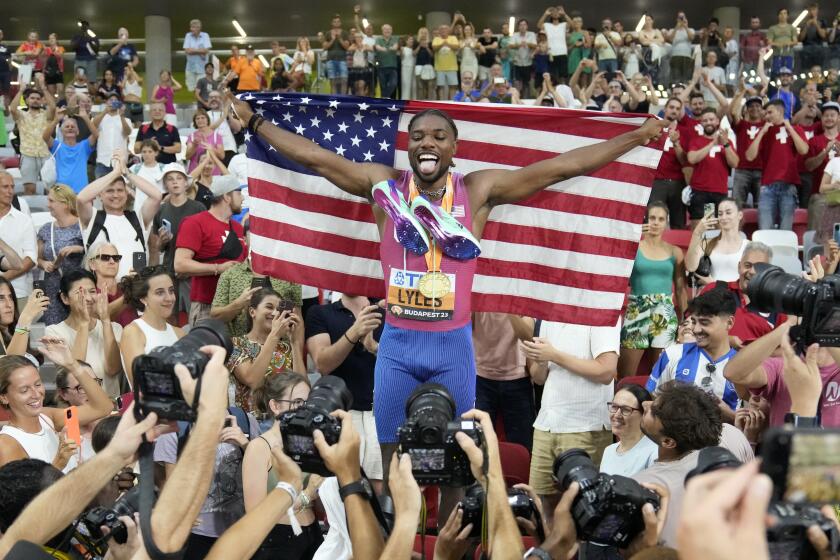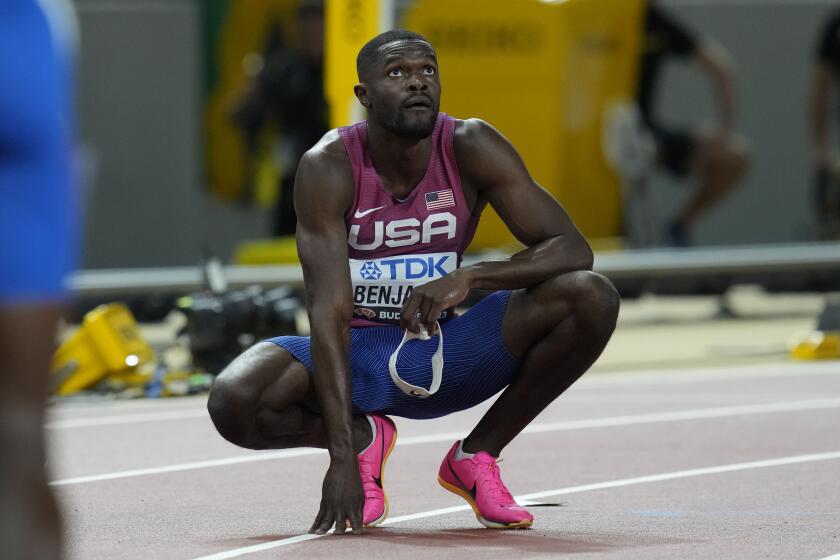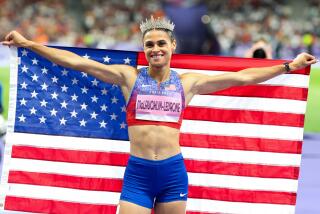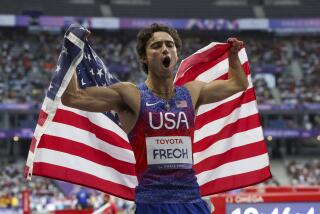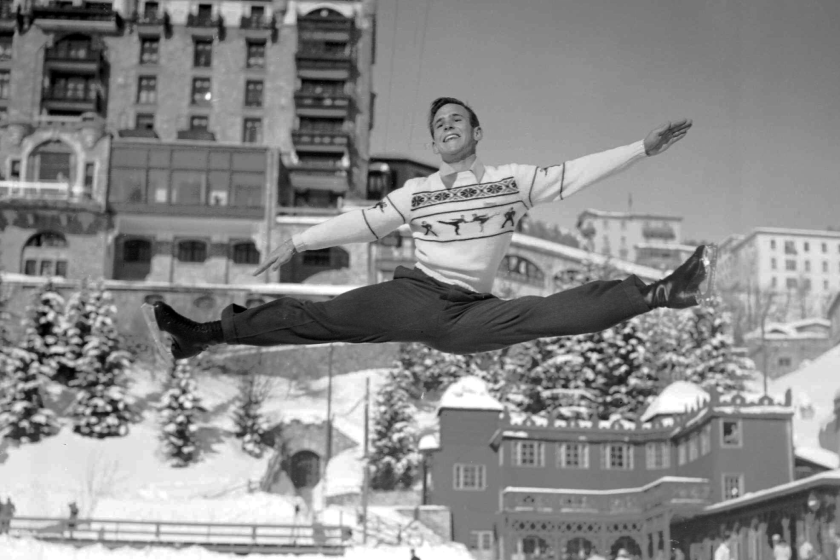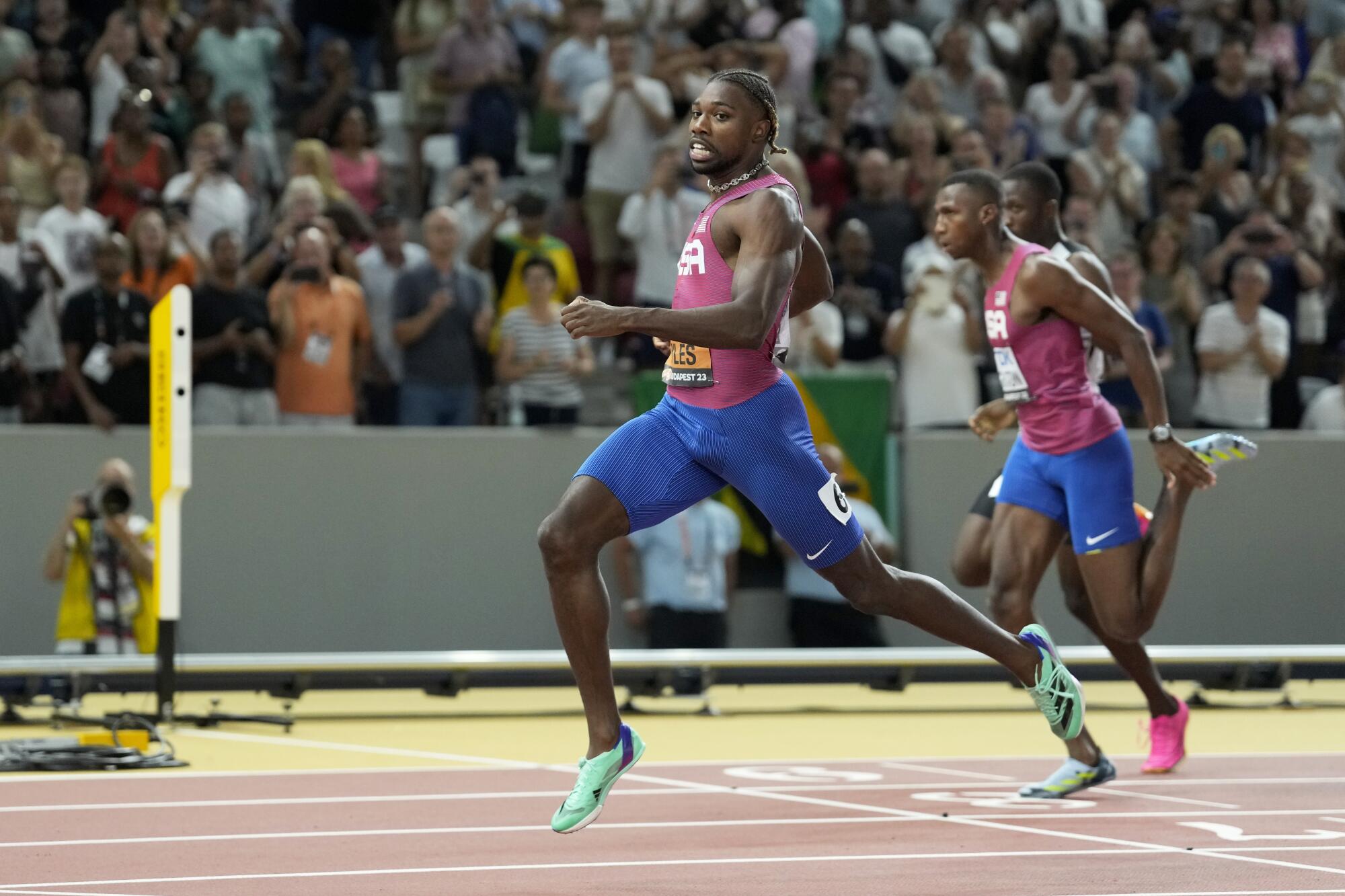
- Share via
After nine days, a dozen U.S. gold medals and a crash involving a golf cart, track and field’s world championships ended Sunday in Budapest, Hungary. It marked the unofficial preview for the Paris Olympics, just 11 months away.
Here are nine questions that were answered in Budapest:
Who will be the most-anticipated athletes to watch in Paris next year?
There isn’t another athlete as consistently dominant over such a range as Kenya’s Faith Kipyegon. Her gold medals in the 1,500 and 5,000 in Budapest capped a year in which she obliterated world records at 1,500 meters, the mile and 5,000 meters in the span of seven weeks this summer. Since 2015, she has won four gold and two silver medals at world championships — and in Paris, Kipyegon will be vying for a third consecutive gold medal at the 1,500.
For the men, it is U.S. sprinter Noah Lyles, who won gold medals in the 100 and 200 and by anchoring the 4x100-meter relay. Though he has won gold in the 200 at the last three world championships, don’t expect any complacency in Paris, where he will be on a mission for redemption after his disappointing bronze in the Tokyo Olympics. Track usually recedes from most casual fans’ awareness in the fall, winter and spring, but Lyles will be everywhere in the lead-up to the Olympics, with one part of a Peacock docuseries on his life already airing and another documenting his world championships to come.
Noah Lyles won the 200 meters on Friday at the world track championships for a sprint double, but Sha’Carri Richardson finished third in the women’s race.
Is the distance-running dominance of Norway’s Jakob Ingebrigtsen inevitable?
Apparently not. Ingebrigtsen is an Olympic champion at 1,500 meters, won gold at 5,000 meters at both the 2022 and 2023 world championships, smashed the world record for two miles in June and in July became the fifth-fastest man over 1,500 meters.
Did we mention he’s only 22?
Yet as the 1,500-meter final at the last two world championships have shown, Ingebrigtsen is susceptible to bad days like any other elite runner. In each race, he led with 200 meters to go but was outkicked into second place. You can be sure another competitor will try to mimic that race plan in Paris. How will Ingebrigtsen counter?
How far off are the Americans from producing a top miler?
As Ingebrigtsen’s consecutive silver medals have revealed, podium parity exists at 1,500 meters, and the U.S. men are awash in young talent, led by Yared Nuguse, who was fifth in Budapest. Nuguse is 24 and this summer set the U.S. record at that distance. Cole Hocker ran a personal best to finish seventh. On the right day, several other U.S.competitors could take their place on next year’s team.
Yet considering the Paris field could include the last two world champions, Great Britain’s Jake Wightman and Josh Kerr, Ingebrigtsen and Niels Laros, an 18-year-old from the Netherlands who finished 10th in Budapest, even a racer with the talent of Nuguse will need a breakthrough to medal in Paris. It has been done before. Just one year after the United States’ Matthew Centrowitz finished eighth at the 2015 world championships, he made all the right moves to win Olympic gold in Rio de Janeiro.
What was an overlooked performance?
The throwing events rarely earn top billing but the U.S. women have turned last year’s breakthrough success into a noticeable trend. In the first 10 world championships to feature women’s hammer throw — from 1999 to 2017 — an American had never medaled. Starting with DeAnna Price’s gold medal in 2019, the U.S. has now taken five medals at the last three world championships, including Janee’ Kassanavoid‘s silver and Price’s bronze in Budapest.
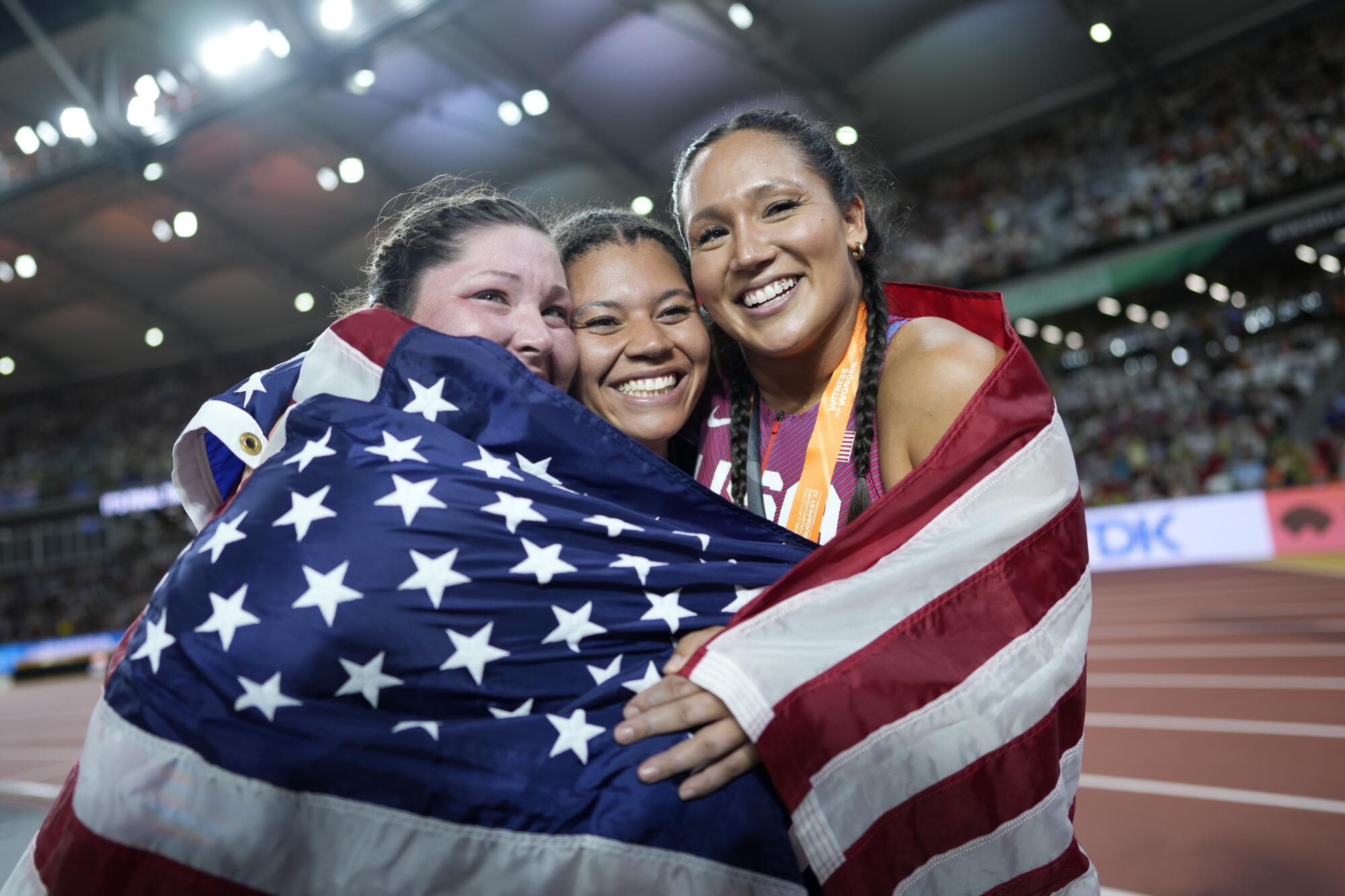
The trend has been similar in discus, where an American woman hadn’t medaled until Valarie Allman’s bronze last year. In Budapest, Allman earned silver and American Laulauga Tausaga earned a stunning gold medal after throwing a 12-foot personal best. And in the shot — an event that had never produced a U.S. gold medal, and only three U.S. medals total, from 1983 to 2019 — Chase Ealey has now won gold at consecutive world championships.
One more honorable mention: JuVaughn Harrison earned silver in the men’s high jump to claim the first U.S. medal in the event at the world championships since Jesse Williams in 2011.
Can Sha’Carri Richardson deliver again on her world-class talent?
The American’s speed was always evident, but so was her inconsistency. Until this year, when for the past four months she produced one strong race after another, and led to the world title at 100 meters and a bronze at 200. The field around her is simply too strong to consider a gold medal in Paris as a foregone conclusion, but after two years where, by her own admission, she had held herself back, Richardson this year showed a blueprint for success she can follow.
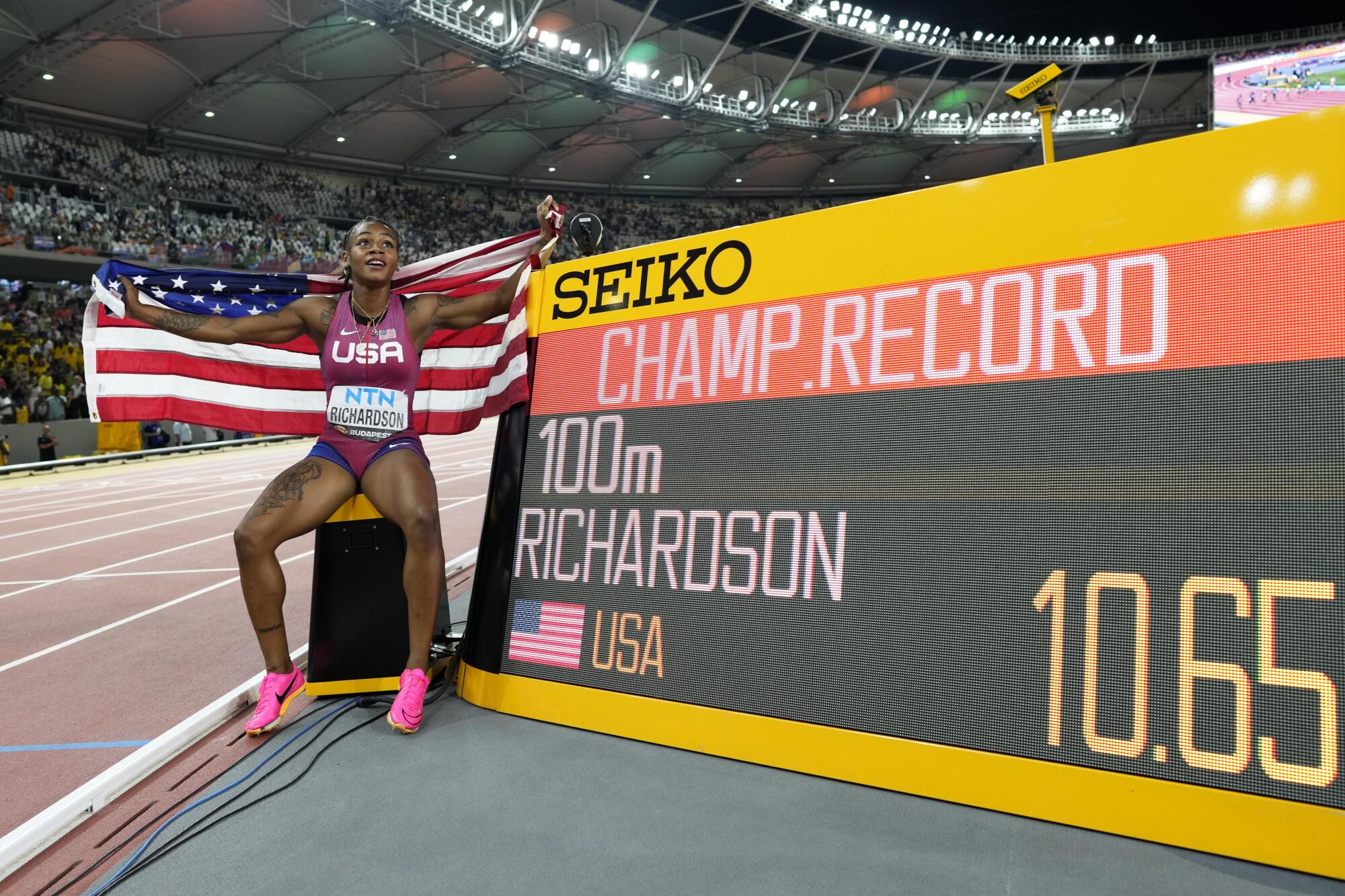
Are the Americans’ relay issues behind them?
Yes and no. The history of U.S. relay exchanges, and the brief relay “camps” and politics that often factor into choosing the country’s pool of relay runners, is so fraught that when a U.S. team does successfully get the baton around, it’s often met more with relief than celebration. In Budapest, three of the four relays were won by the U.S., but not without a close call in women’s 4x100-meter qualifying and a botched handoff that cost the U.S. women a spot in the 4x400-meter final.
Is it still possible to believe Sydney McLaughlin-Levrone could compete in the 400 meters and 400 hurdles in Paris?
The decision, of course, will ultimately be decided by McLaughlin-Levrone’s health — the American star missed these world championships because of a knee injury — and whether she wants to put herself through three rounds of races for each event at the Olympics. But if the question is could she win the open 400, and 400 hurdles next year, that answer remains yes. Femke Bol, who won the hurdles in McLaughlin-Levrone’s absence, is a fierce competitor — just watch her gutsy comeback to help the Netherlands secure a gold in the 4x400-meter relay — but is still 0.77 seconds behind the world record of McLaughlin-Levrone, who has made a habit of running her best races on the biggest stages. In the open 400, new world champion Marileidy Paulino of the Dominican Republic will be waiting, but it would seem encouraging for McLaughlin-Levrone that in only her fifth 400 of this season, she ran a time that would have won in Budapest. Considering how quick of a study she proved at the 400 this season, it would suggest there is plenty of potential should she focus more on that event in the coming year.
Did these championships offer a hint to what might be the best race in Paris?
The deepest fields could again be the men’s 400-meter hurdles, led by Norway’s Karsten Warholm and former UCLA and USC standout Rai Benjamin, and women’s 800. Athing Mu of the U.S., the 21-year-old former Olympic and world champion who trains in Los Angeles under Bobby Kersee as part of a group that includes McLaughlin-Levrone, earned bronze in Budapest, her first loss in an 800-meter final since 2020. That string of victories masked how hard she had to fight for those titles against evenly matched competition. The two women who moved past her in the final 50 meters in Budapest, Kenya’s Mary Moraa and silver medalist Keely Hodgkinson of Great Britain, will make the Olympic title at 800 meters a toss-up.
Norway’s Karsten Warholm, the world record-holder in the 400-meter hurdles, won the gold with Kyron McMaster second ahead of Rai Benjamin.
There was strong attendance in Budapest. Are track and field’s concerns about its popularity unfounded?
Not really. The surprise would have been if these world championships weren’t well-attended, given the sport remains popular in Europe. It didn’t answer any of the concerns about the sport’s health within the U.S. Many top athletes, agents and coaches still chafe about USA Track & Field’s governance, the sport’s confusing meet calendar and the lack of exposure it creates, and the lack of distinction between those who are professional and those who are not. As Richardson tweeted, in part, on July 12: “Track&Field is not like other sports especially in America. The NBA, NFL have organizations to HELP their athletes, not exploit them.” Meet promoters, in turn, are always concerned that top names can drop out of competing only days before a meet, making them difficult to promote. There have been signs of progress, with the American Track League affording professionals opportunities to compete without traveling internationally, but track will need an outside spark for casual fans to invest their time in the sport. Many are pinning those hopes on a Netflix docuseries centered on top sprinters that will debut in 2024, because it is being produced by the same company that made a Netflix series on Formula One that skyrocketed that sport’s popularity from niche to mainstream.
More to Read
Go beyond the scoreboard
Get the latest on L.A.'s teams in the daily Sports Report newsletter.
You may occasionally receive promotional content from the Los Angeles Times.

